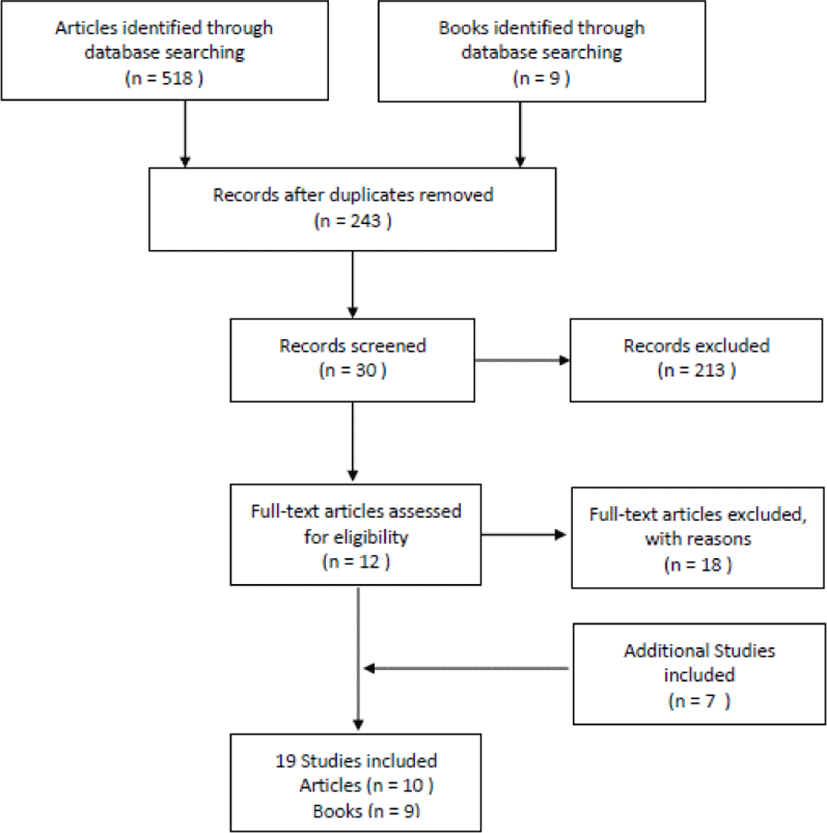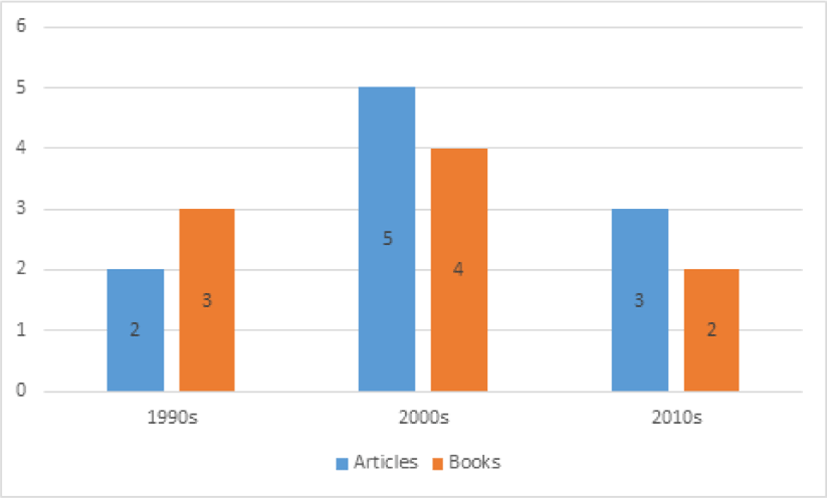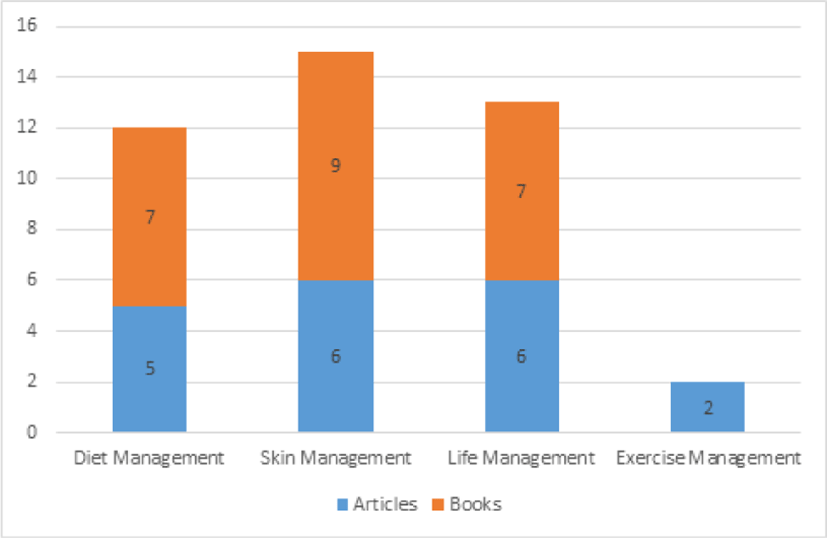Ⅰ. 서 론
피부는 인체와 외부의 경계가 되며 외부에 직접 노출되어 있다1). 현대 사회에 이르러 피부 미용에 대한 사람들의 관심은 증가하였으며, 그로 인하여 피부 질환에 대한 사람들의 관심 역시 증가하였다2). 피부 질환은 환자의 정서적인 측면뿐 아니라 대인관계, 사회생활에 영향을 미치며 심한 경우 우울증, 불안, 자신감 결여 등으로 인해 삶의 질의 저하를 초래한다3).
여드름은 모낭-피지선 단위에서 발생하는 만성염증성 질환이다4). 전 인구의 80%가 경험하는 피부질환인 여드름은 일반적으로 사춘기를 전후로 발생하며 20세 중반부터 소실되기 시작된다5). 그러나 최근에는 환경과 스트레스 등 사회적 요인으로 인하여 성인에 이르러서까지 여드름이 지속되는 경우가 많아지는 추세이며, 여드름 환자의 평균 연령 역시 점진적으로 증가하고 있다6-8). 서구의 여드름 유병률 조사에서는 12 ~ 25세에서 85%, 25세 ~ 34세에서 8%, 35세 ~ 44세에서는 3%로 나타났다8).
여드름의 특징적인 병변으로는 면포, 홍반성 구진, 농포, 낭종, 결절 등이 있으며, 주된 병소로는 피지 분비가 많은 얼굴, 목, 등, 가슴 등이 있다9,10). 여드름의 병인과 발병기전은 명확하진 않다. 다만, 비정상적인 모낭의 이상 각화, 피지 분비의 증가, 세균의 증식과 그로 인한 염증 유발 등의 요인이 복합적으로 영향을 미치는 것으로 추정된다11). 그 외에 스트레스, 월경주기, 잘못된 생활습관 및 식습관 등에 의해 증상이 악화되는 것으로 알려져 있다12).
여드름 치료 방법에 대하여 살펴보면 여드름 치료에 대한 수요가 증가함에 따라 다양한 치로 방법들이 개발되어 사용되고 있으나, 아직까지 여드름 치료에 있어 효과적인 단일 치료술은 없는 것으로 나타났다3,10). 현재 사용되고 있는 여드름 치료법으로는 일상생활에서의 피부청결유지, 항생제, 여성호르몬제, 부신피질호르몬제 등의 경구투여, retinoids, 항생제, benzoyl peroxide 등을 이용한 국소도포, 스테로이드 호르몬제 국소주사 등이 있다. 그 외에도 여드름 압출법, 박피술, 레이저 치료술 같은 외과적 치료법이 활성화되어 있다3,4,13).
한의학에서는 오래전부터 여드름을 하나의 질병으로 인식하였다13). 여드름은 黃帝內經에서 처음으로 痤疿라 불리기 시작하였으며, 그 외에도 증상이나 원인, 호발하는 시기 등에 따라 痤瘡, 痤, 面瘡, 面疱, 肺風瘡, 肺風粉刺, 靑春痘 등 다양한 이름으로 지칭되었다. 여드름의 대표적인 병인병기로는 風邪에 外感하여 肺熱이 宣泄되지 않거나 膏粱珍味의 과도한 섭취로 腸胃에 濕熱邪가 생겨 그것이 얼굴로 上薰하여 발생하는 것으로 바라보았다14). 여드름을 치료할 때는 내치법과 함께 다양한 외치법을 사용하였다.
현대 사회에서는 질병의 치료뿐 아니라 질병의 예방, 관리, 건강증진의 중요성이 부각되고 있다. 한의학에서는 養生이란 개념을 통해 질병의 예방 및 관리에 대한 중요성을 인지하였다15). 養生이란 신체적, 정신적 안정을 추구하고 자연과의 조화로운 생활을 지향하는 한의학적 개념이다16). 養生의 목적은 사람의 건강을 유지 및 증진시키는 것이다17). 그러나 질병의 치료에 대한 연구에 비해 養生, 즉 질병의 예방 및 관리에 대한 연구는 미흡한 실정이다18). 따라서 본 연구는 여드름의 예방 및 관리에 대한 자료들을 종합적으로 정리하여 유효성 있는 기초자료를 마련하고자 하였다.
Ⅱ. 대상 및 방법
여드름에 대한 예방 및 관리에 관한 연구 중 국내의 학술지에 출판된 논문 및 여드름과 관련된 도서를 대상으로 문헌고찰 연구를 진행하였다. 그 외에 여드름에 대한 예방 및 관리에 대한 내용이 포함된 여드름 증례보고나 치험례를 포함하였다. 출판 시기는 1990년 이후부터 검색일(2018년 8월) 이전까지 출판된 문헌연구와 증례보고를 포함한 임상연구를 대상으로 하였다.
검색엔진은 RISS(Research Information Service System), KISS(Korean Studies Information Service System), NDSL (National Digital Science Library), OASIS(Korean Medicine Information System)를 이용하였다. 검색어는 여드름의 예방 및 관리와 관련된 논문을 검색하기 위해 “여드름”과 “예방”, “관리”를 조합하여 사용하였다. 또한 증례보고를 포함한 임상연구를 검색하기 위해 검색어는 “여드름”과 “증례”, “치험례”, “case”를 조합하여 사용하였다.
도서 검색을 위하여 전라북도 전주시에 위치하는 전주시립서신도서관 및 전주시립완산도서관의 검색 엔진을 이용하였다. 검색어로는 “여드름”을 이용하여 분석을 진행하였다. 검색엔진은 표에 정리하여 제시하였다(Table 1).
| Databases Title | Site URL |
|---|---|
| KISS (Korean Studies Information Service System) |
http://kiss.kstudy.com |
| RISS (Research Information Service System) |
http://www.riss.kr |
| NDSL (National Digital Science Library) |
http://www.ndsl.kr/index.do |
| OASIS (Korean Medicine Information System) |
http://oasis.kiom.re.kr |
| Jeonju Municipal Library | http://lib.jeonju.go.kr/index.jeonju |
각 데이터베이스을 활용하여 조사한 결과 총 527개의 도서 및 국내 학술지 논문이 검색되었다. 중복된 연구를 제거하고 추출된 243편을 대상으로 제목을 검토하였다. 검토한 결과 최종적으로 국내 학술지 논문 23편, 도서 7편, 총 30편의 연구를 얻었다. 이 30편 의 연구를 대상으로 전문 screening을 통해 최종적으로 국내 학술지 논문 10편, 도서 2편을 얻었으며, 추가적으로 여드름의 예방 및 관리에 대한 도서 7편을 추가해 총 19편의 연구를 얻었다. 이 19편의 연구를 출판연도별, 방법별, 내용별로 분류하여 분석하였다(Fig. 1).
Ⅲ. 결 과
여드름의 예방 및 관리 방법에 대한 문헌 19개를 출판연도별로 분석하였다. 1990년대에 출판된 문헌은 논문 2편, 도서 3편, 총 5편(26.3%)으로 나타났다. 2000년대에 출판된 문헌은 논문 5편, 도서 4편, 총 9편(47.3%)으로 나타났으며, 2010년대에 출판된 문헌은 논문 3편, 도서 2편, 총 5편(26.3%)으로 나타났다. 분석 결과는 아래 표로 정리하였다(Fig. 2).
여드름의 예방 및 관리 방법을 ‘식이 관리’, ‘피부 관리’, ‘생활 관리’, ‘운동 관리’ 네 가지 분류하였다. 논문 10편과 도서 9편의 연구를 분석한 결과, ‘식이 관리’에 대한 내용이 포함된 문헌은 논문 5편, 도서 7편, 총 12편으로 나타났다. ‘피부 관리’에 대한 내용이 포함된 문헌은 논문 6편, 도서 9편, 총 15편으로 나타났다. ‘생활 관리’에 대한 내용이 포함된 문헌은 논문 6편, 도서 7편으로 총 13편인 것으로 나타났다. ‘운동 관리’에 대한 내용이 포함된 문헌은 논문 2편으로 나타났으며, 도서는 없는 것으로 나타났다(Fig. 3). 각 연구들의 내용을 분석한 결과는 아래 표와 같다(Table 2).
| Author(year) | Publications | Prevention & Management | Detail |
|---|---|---|---|
| Woo(1992)19) | Book | Diet Management | - Avoide cream, sugar, chocolate, cocoa, butter, cheese, pork, ham, bacon, spices - Intake of beef, fish, chicken, fresh vegetables and fruits |
| Skin Management | - Enough cleansing | ||
| Life Management | - Smooth bowel movements - Get enough sleep - Relieve stress |
||
| Kim(1995)20) | Article | Diet Management | - Intake of vegetables, fruits, seaweeds(keep blood alkaline - Alcohol abstinence |
| Skin Management | - Keep skin clean(thorough cleansing) - Cleanse with warm water below 40 degrees, rinse with cold water - Maintain hair shape that hair does not touch face |
||
| Life Management | - Have a balanced meal - Keep smooth bowel movements(pay attention to constipation) - Proper sleep and exercise |
||
| Kim(1997)21) | Book | Diet Management | - Vitamin A high-content food |
| Skin Management | - Keep clean | ||
| Park(1997)22) | Book | Diet Management | - Consuming many vegetables and fruits with fiber(smooth bowel movements) - Take mung bean and lily for 30g each when cooked - Avoid spicy food, high fat diet, sugar-high foods - Alcohol abstinence |
| Skin Management | - Keep skin clean(enough cleansing) - No skin contact, no extrusion - Makeup lightly |
||
| Life Management | - Relieve stress - Get enough sleep - Sleep early and get up early(Associated with the metabolism of skin cells) - Do not overeat - No smoking |
||
| Kim(1999)23) | Article | Diet Management | - Avoid excessive intake of instant, sweet, flour, and fatty foods - Increase fruit or vegetarian intake |
| Skin Management | - Keep skin clean - Avoid excessive sunlight(screening UV) - Avoid physical skin friction |
||
| Life Management | - Get sufficient rest and relieve stress - Regular lifestyle |
||
| Excersise Management | - Exercises to promote blood circulation eg)Jump rope | ||
| Choi(2000)5) | Article | Life Management | - Maintain proper eating habits and lifestyle |
| Kim(2002)24) | Book | Skin Management | - Keep skin clean(adequate cleansing) - UV protection(apply sunscreen) |
| 정(2002)25) | Book | Skin Management | - Use acne soap and cosmetics - Do not touch or extrude |
| Life Management | - Relieve fatigue and stress | ||
| Lee(2006)26) | Article | Skin Management | - Using acne cosmetics - Facial exfoliation, sebum removal, sterilization, inflammation suppression management, toxin emission management, moisturizing management, protection management - Skin scaling, peeling management, etc. |
| Life Management | - Lymphatic massage, aroma care, spa therapy, meridian massage, | ||
| Jin(2007)27) | Article | Life Management | - Have breakfast. - Restriction of snack intake |
| Excersise Management | - Walking 35 minutes at an average speed of 6km/h mainly for aerobic exercise | ||
| Yang(2008)28) | Article | Diet Management | - Enough water intake |
| Skin Management | - Keep your skin healthy with thorough cleansing - Identify the exact skin condition and type - Skin care before and after shaving - Excessive sebum control - Use sunscreen |
||
| Seo(2009)29) | Book | Diet Management | - Avoid high-fat foods, sugar-high foods - Alcohol abstinence |
| Skin Management | - Keep skin clean(Managing sebum and pores) - UV protection(apply sunscreen) |
||
| Life Management | - No smoking - Relieve stress - Get enough sleep |
||
| Song(2009)30) | Book | Diet Management | - Avoid fried foods, flour foods - Keep sweets and soft drinks away - Drink milk(Vitamin B, B2-rich) - Steady ingestion of fresh fruits and vegetables(Vitamin C-rich) - Sufficient water intake - Alcohol abstinence |
| Skin Management | - Choice of natural cosmetics - Cleansing before exercise - UV protection |
||
| Life Management | - Restrain midnight snack - No smoking - Relieve stress - Get enough sleep - Excretion of waste by lymphatic massage |
||
| Oh(2009)31) | Article | Diet Management | - Avoid instant foods, breads and noodles |
| Logan(2011)32) | Book | Diet Management | - Recommended to consume vegetables and fruits, seaweeds, fish, meat, nuts and fermented foods - Avoid foods with high sugar content(such as bananas, watermelons), starchy vegetables(potatoes, sweet potatoes, corn), processed meats, cheese, white rice, white flour, and high fat foods |
| Skin Management | - Adequate cleansing(Two or three times a day) | ||
| Life Management | - Proper sleep | ||
| Jeong(2011)33) | Book | Diet Management | - Avoid fatty, sugary, stimulating, heaty, instant foods - Intake food rich in protein, minerals, vitamins B2, B6, and C - Alcohol abstinence |
| Skin Management | - Adequate cleansing | ||
| Life Management | - No smoking | ||
| Ha(2011)34) | Article | Life Management | - Have regular eating habits and sleep habits |
| Na(2013)35) | Article | Skin Management | - Keep clean - Using acne cosmetics |
| Kim(2017)36) | Article | Diet Management | - Restrain Greasy food - Alcohol abstinence |
| Skin Management | - Moisturizing with mask packs and cosmetics - Carefully scrub face with a scrub product once a week - If you feel a sense of warmth, cool it with a mist |
논문 및 도서 총 19편을 대상으로 ‘식이 관리’, ‘피부 관리’, ‘생활 관리’, ‘운동 관리’에 해당하는 내용을 ‘권장’ 혹은 ‘제한’ 두 가지로 분류하여 분석하였다. 분석한 내용은 아래 표와 같다(Table 4). ‘식이 관리’의 경우 ‘과일 및 채소류’ 섭취를 권장하는 연구가 총 6건(논문 2건, 도서 4건)으로 가장 많았으며, ‘기름진 음식 및 고지방 음식’의 섭취를 제한하는 연구가 총 7건(논문 2건, 도서 5건)으로 가장 많았다. ‘피부 관리’의 경우 철저한 세안을 권장하는 연구가 논문 4건, 도서 8건, 총 12건으로 가장 많았으며, 피부 접촉을 제한하는 연구가 총 4건(논문 2건, 도서 2건)으로 가장 많았다. ‘생활 관리’의 경우 규칙적이고 충분한 수면 및 휴식을 권장하는 연구가 총 9건(논문 3건, 도서 6건)으로 가장 많았으며, 흡연을 제한하는 연구가 총 4건(도서 4건)으로 가장 많았다. ‘운동 관리’의 경우 걷기와 줄넘기를 권장하는 연구가 각각 1건(논문 1건)으로 나타났다.
Ⅳ. 고 찰
최근 한의약 건강관리의 관심이 기존 침 치료나 한약 처방과 같은 치료의 개념에서 건강 유지, 증진 및 예방으로 전환되고 있다2). 여드름은 전 인구의 80%가 경험하는 매우 흔한 피부질환으로, 발생 후 자연적으로 개선되기도 하지만 일부 흉터, 색소침착 등이 발생할 수 있어 관리에 주의가 필요하다5,37). 특히, 여드름의 경우 안면부에 발생하는 경우가 많아 다른 질환에 비해서 관리에 대한 관심이 높은 편이다38,39). 하지만, 기존의 한의약 관련 논문은 여드름 치료에 대해서 중점적으로 연구가 되었으며 예방 및 관리에 대한 연구는 부족한 편이다. 이에 본 연구진은 데이터베이스 검색을 통해 여드름의 예방 및 관리에 대한 문헌들을 조사하여 출판연도별, 방법별, 내용별로 분류하여 분석하였다.
출판연도별 분석에서는 문헌들의 출판연도를 십년 단위로 분류하여 정리하였다. 분석한 내용을 살펴보면 1990년대에 이루어진 연구들(26.32%)에 비해 2000년대에 이루어진 연구들(47.36%)이 20% 가량 더 많 았으며, 2010년대에도 일부 연구들(26.32%)이 진행되었다. 1990년대에 비해 2000년대에 들어 더 많은 연구가 진행된 것은 현대 사회에 이르러 소득 수준이 향상됨에 따라 피부 관리에 대한 사람들의 관심이 증가하였고, 그로 인해 여드름에 대한 사람들의 관심도 증가하였기 때문으로 사료된다39).
방법별 분석에서는 여드름의 예방 및 관리법을 ‘식이 관리’, ‘피부 관리’, ‘생활 관리’, ‘운동 관리’ 네 가지로 분류하여 정리하였다. 분석한 내용을 살펴보면 피부 관리에 대한 내용을 포함한 문헌이 15편으로 가장 많았다. 피부 관리 외에 생활 관리에 대한 내용을 포함하는 문헌은 13편, 식이 관리에 대한 내용을 포함하는 문헌은 12편으로 나타났으며, 운동 관리에 대한 내용을 포함하는 문헌은 2편으로 나타났다. 여드름은 피부에 발생하는 질환이므로 직접적인 피부 관리가 여드름의 예방 및 관리법에 가장 많은 비중을 차지하는 것으로 사료된다. 그러나 다른 피부 질환과 달리 여드름의 예방 및 관리법에 식이 관리와 생활 관리에 대한 내용이 다수 포함된 점을 주목할 필요가 있다. 한의학에서는 얼굴을 오장육부의 거울이라 하여 오장육부의 상태를 판단할 수 있는 중요한 지표로 바라보았다38). 또한, 문헌에 따라 편차는 있지만 여드름의 병인을 주로 肺熱, 血熱, 腸胃濕熱, 脾虛濕痰 등 외과적 관점이 아닌 내과적 관점으로 바라보았다40). 여드름의 예방 및 관리법에 생활 관리 및 식이 관리에 대한 내용이 다수 포함된 것은 이러한 한의학적 관점이 반영된 것으로 사료된다.
내용별 분석에서는 각 문헌들의 내용을 권장 및 제한으로 분류하였다. 식이 관리의 경우 과일 및 채소류의 섭취를 권장하는 내용이 가장 높은 비율을 차지하였고, 기름진 음식 및 고지방 음식의 섭취를 제한하는 내용이 가장 높은 비율을 차지하였다. 과일 및 채소류는 섬유질이 풍부하여 배변활동을 원활하게 해준다. 배변활동이 원활하지 않을 경우 체내에 독소가 쌓여 피지의 분비가 증가하고, 여드름이 악화될 수 있다20). 또한, 한의학에서는 기름진 음식 및 고지방 음식을 膏粱珍味라 하여, 膏粱珍味를 과다 섭취할 경우 痰飮이 형성된다고 바라보았다. 痰飮이 체내에 축적되면 氣機가 不暢하여 內熱이 조장될 수 있고, 열이 燻蒸하여 안면부로 상승하면 여드름이 악화될 수 있다20,41). 식이 관리에서 과일 및 채소류 섭취를 권장하고 기름진 음식 및 고지방 음식의 섭취를 제한하는 내용이 높은 비율을 차지하는 것은 이러한 병리적 기전에서 기인한 것으로 사료된다. 피부 관리의 경우 철저한 세안을 권장하는 내용이 가장 높은 비율을 차지하였고, 피부접촉을 제한하는 내용이 가장 높은 비율을 차지하였다. 안면부에 피지가 과다 분비되어 모공이 막히거나 혹은 세균에 감염되어 피지선 내에 염증 유발되면 여드름이 발생 및 악화될 수 있다23,35). 피부 관리에 철저한 세안을 권장하고 피부 접촉을 제한하는 내용이 가장 높은 비율을 차지하는 것은 이러한 연유 때문으로 사료된다. 생활 관리의 경우 충분한 수면 및 휴식을 권장하는 내용이 가장 높은 비율을 차지하였고, 흡연을 제한하는 내용이 가장 높은 비율을 차지하였다. 수면 부족은 피부세포의 신진대사를 저하시키며 세포의 영양공급 및 대사를 원활하지 않게 만들어 피부건강에 악영향을 미친다. 또한 수면 부족은 스트레스를 유발하여 교감신경계를 자극하고 다양한 호르몬의 분비를 촉진한다. 교감신경의 과도한 반응과 호르몬들의 분비는 모공 내의 염증을 유발하여 여드름을 악화시킬 수 있다42,43). 생활 관리에 충분한 수면 및 휴식을 권장하는 내용이 높은 비율을 차지하는 것은 이러한 이유들에 기인한 것으로 사료된다. 담배의 니코틴은 혈관을 수축시키고, 체내 혈액순환의 장애를 초래하여 피부 건강에 악영향을 미친다. 또한 담배에 함유된 각종 화학물질들은 피부를 자극하여 여드름을 악화시킬 수 있다44). 이러한 이유들로 생활 관리에 흡연을 제한하는 내용이 높은 비중을 차지하는 것으로 사료된다. 운동 관리의 경우 걷기와 같은 혈액순환을 촉진하는 운동을 권장하는 내용이 포함되었다. 운동 강도가 지나칠 경우 안면의 혈류량이 증가하면서 피부의 온도가 상승하여 홍반을 야기할 수 있다. 그러나 적절한 강도의 운동은 모세혈관 내 혈류의 흐름을 증가시키고, 노폐물을 배출시켜 피부 건강에 도움이 된다45). 이러한 이유들에 기인하여 여드름의 예방 및 관리법에 혈액 순환을 촉진할 수 있는 간단한 운동들을 권장하는 것으로 사료된다. 그러나 위의 결과는 문헌별로 다소 편차가 존재하기 때문에 추후 체계적인 연구가 필요할 것으로 사료된다.
1990년 이후 수행된 여드름의 예방 및 관리에 대한 연구는 총 19편으로 1년에 평균 0.66편의 연구가 진행되었다. 이는 여드름의 예방 및 관리에 대한 연구가 양적으로 크게 미흡하여 여드름의 예방 및 관리에 참고할 만한 문헌이 다소 부족한 실정임을 보여준다. 따라서 향후 여드름의 예방 및 관리에 대한 연구가 활발하게 진행되어야겠으며, 궁극적으로 체계적인 여드름의 예방 및 관리를 통해 건강의 증진을 도모할 수 있도록 하여야겠다.
본 연구가 얻은 결과는 한정된 데이터베이스만을 검색하여 얻은 정보이기 때문에 관련된 모든 연구를 포함하였다고 볼 수 없다. 또한 국내학술지에 출판된 연구와 일부 도서관의 도서를 대상으로 하였기 때문에 해외 학술지논문, 모든 도서 및 보고서 등을 포함하지 못했다는 한계가 있다. 추후 여드름의 예방 및 관리에 대하여 체계적인 연구가 필요할 것으로 사료된다.
Ⅴ. 결 론
본 연구는 국내 데이터베이스 검색을 통해 여드름의 예방 및 관리에 대한 문헌들을 고찰한 결과 다음과 같은 결론을 얻었다.
-
총 19편의 문헌을 출판된 연도별로 살펴보면 1990년대에 출판된 문헌은 5편(26.3%)으로 나타났으며, 2000년대에 출판된 문헌은 9편(46.3%), 2010년대에 출판된 문헌은 5편(26.3%)으로 나타났다.
-
총 19편의 문헌 중 식이 관리에 대한 내용이 포함된 문헌은 총 12편(논문 5편, 도서 7편), 피부 관리에 대한 내용이 포함된 문헌은 총 15편(논문 6편, 도서 9편)으로 나타났다. 생활 관리에 대한 내용이 포함된 문헌은 총 13편(논문 6편, 도서 7편)으로 나타났으며, 운동 관리에 대한 내용이 포함된 문헌은 총 2편(논문 2편)으로 나타났다.
-
식이 관리에서는 과일 및 채소류의 섭취를 권장하고, 기름진 음식 및 고지방 음식의 섭취를 제한하는 내용의 비율이 가장 높았다.
-
피부 관리에서는 철저한 세안을 권장하고, 피부 접촉을 제한하는 내용의 비율이 가장 높았다.
-
생활 관리에서는 충분한 수면 및 휴식을 권장하고, 흡연을 제한하는 내용의 비율이 가장 높았다.
-
운동 관리 경우 혈액 순환을 촉진할 수 있는 간단한 운동들을 권장하는 내용이 일부 포함되었다.
본 연구를 통해 여드름의 예방 및 관리에 다양한 방법들이 활용되고 있음을 알 수 있었으며, 향후 추가적인 연구를 통해서 여드름의 예방 및 관리에 대한 연구 수준을 향상시킬 필요가 있겠다.









